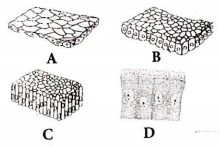 Multiple Choice Questions
Multiple Choice QuestionsIn frog heart, there are cardiac muscles which consists of fibres called
Purkinje fibres
myonemes
telodendria
columnae carnae
Malphigian tubules are
excretory organs of insects
excretory organs of frog
respiratory organs of insects
endocrine glands of insects
Inner lining of blood vessels is formed by
ciliated epithelium
squamous epithelium
cubical epithelium
columnar epithelium
In frog chromosome number is reduced to half
when 2nd polar body is separated
when 2nd polar body is divided
when 3rd polar body is separated
when 1st polar body is separated
The figure shows different human tissues labelled as A to D. Which option gives the correct identification of the label, its location and one feature.

D-Unicellular glandular epithelium, goblet cells, secrete saliva
B-Squamous epithelium, walls of blood vessels, form a diffusion boundary
A-Cuboidal epithelium, ducts of glands, secretion and absorption
C-Columnar epithelium, lining of stomach, secretion and absorption
D.
C-Columnar epithelium, lining of stomach, secretion and absorption
The given figure
A is squamousepithelium, found in walls of blood vessels and air sacs of lungs and is involved in functions like forming a diffusion layer.
B is cuboidal epithelium, found in ducts of glands and tubular parts of nephrons of kidney and its main functions are secretion and absorption.
C is columnar epithelium, found in lining of stomach and intestine and helps in secretion and absorption.
D is ciliated columnar epithelium, present in inner surface of hollow organs like bronchioles and Fallopian tubes and helps to move particles or mucus in a specific direction over the epithelium.
Pacinian corpuscles occur in the skin of certain parts of body in mammals. These are
type of glands
pain receptors
naked tactile receptors
encapsulated pressure receptors.
